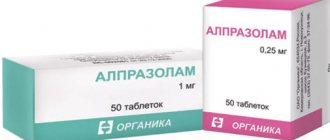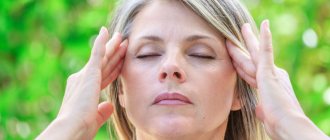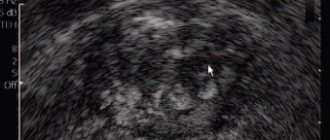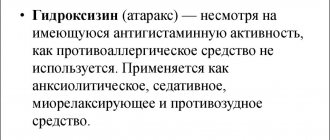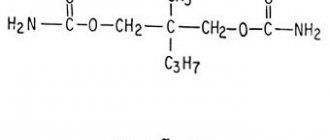The scourge of the 21st century is stress. His faithful companions: anxiety, excitement, neuroses, panic attacks, somatic manifestations (urticaria, skin itching, allergic dermatitis, eczema), sleep disturbances. It would seem that there’s nothing wrong with it, just rest and everything will pass. But if it does not go away, gets worse and disrupts the usual rhythm of life, then you need to consult a doctor. During drug treatment, doctors often prescribe a prescription for the anxiolytic (tranquilizer) Atarax, which is allowed even for children over one year of age.
Stress is a very common problem
pharmachologic effect
A derivative of diphenylmethane, it has moderate anxiolytic activity;
It also has a sedative, antiemetic, antihistamine and m-anticholinergic effect. Blocks central m-cholinergic receptors and histamine H1 receptors and inhibits the activity of certain subcortical zones. Does not cause mental dependence or addiction. The clinical effect occurs 15-30 minutes after taking the drug orally. Has a positive effect on cognitive abilities, improves memory and attention. Relaxes skeletal and smooth muscles, has bronchodilator and analgesic effects, and a moderate inhibitory effect on gastric secretion. Hydroxyzine significantly reduces itching in patients with urticaria, eczema and dermatitis. With long-term use, there was no withdrawal syndrome or deterioration of cognitive functions. Polysomnography in patients with insomnia and anxiety clearly demonstrates an increase in sleep duration and a decrease in the frequency of night awakenings after a single or repeated dose of hydroxyzine at a dose of 50 mg. A decrease in muscle tension in patients with anxiety was noted when taking the drug at a dose of 50 mg 3 times a day.
Composition of the medicine
The main active component - hydroxyzine - has a calming, anti-allergenic, analgesic, antispasmodic effect, and also increases concentration, improves attention and cognitive functions. If anxiety is pronounced, and chronic insomnia is also associated with it, then Atarax, or rather hydroxyzine, relieves anxiety, normalizes sleep, strengthening and increasing its duration, and reduces the frequency of awakenings at night. The drug is able to relax skeletal muscles, as well as smooth muscles. All this is due to the effect of the drug Atarax on certain areas of the subcortical zones of the brain.
The drug is absorbed into the gastrointestinal tract, after which it quickly enters the systemic circulation. That is why the effect of taking Atarax is noticeable within 15-30 minutes.
If you take Atarax for a long time, then addiction or dependence on the drug will not develop. This means that he does not have “withdrawal syndrome”.
Pharmacokinetics
Suction
Hydroxyzine is highly absorbed from the gastrointestinal tract. Cmax is observed 2 hours after taking the drug.
After a single dose of the drug in a single dose of 25 mg or 50 mg in adults, the plasma concentration is 30 ng/ml and 70 ng/ml, respectively.
Bioavailability when taken orally and intramuscularly is 80%.
Distribution
Hydroxyzine is more concentrated in tissues (particularly skin) than in plasma. The distribution coefficient is 7-16 l/kg.
Hydroxyzine penetrates the BBB and the placental barrier, concentrating more in the fetal tissues than in the mother's body. Metabolites are found in breast milk.
Metabolism and excretion
Hydroxyzine is metabolized in the liver. The main metabolite (45%) is cetirizine, which is a histamine H1 receptor blocker. The total clearance of hydroxyzine is 13 ml/min/kg. T1/2 in adults is 14 hours. Only 0.8% of hydroxyzine is excreted unchanged in the urine.
Pharmacokinetics in special clinical situations
In children, the total clearance is 4 times less than in adults, T1/2 in children aged 14 years is 11 hours, in children aged 1 year - 4 hours.
In elderly patients, T1/2 is 29 hours, the distribution coefficient is 22.5 l/kg.
In patients with impaired liver function, T1/2 increases to 37 hours, the concentration of metabolites in the blood serum is higher than in young patients with normal liver function. The antihistamine effect can last for 96 hours.
Indications
- adults: for the relief of anxiety, psychomotor agitation, feelings of internal tension, increased irritability in neurological, mental (including generalized anxiety, adaptation disorders) and somatic diseases, chronic alcoholism; withdrawal syndrome in chronic alcoholism, accompanied by psychomotor agitation;
- as a sedative during premedication;
- skin itching (as symptomatic therapy).
Atarax for neuroses and panic attacks
Neuroses are a fairly common diagnosis. This is a reversible neuropsychic disorder, which is provoked by constant stress, chronic fatigue, tension and anxiety. Neuroses are often accompanied by panic attacks. A panic attack is a state of sudden and extremely intense attack of fear or anxiety. Refers to neurotic diseases.
For such conditions, the doctor may prescribe Atarax. The main purpose of this tranquilizer is to calm and relieve anxiety. The product must be used strictly as prescribed by the doctor in the prescribed dosage and regularity. Atarax suppresses the activity of certain areas of the brain, relieving tension and panic attacks.
Contraindications
- porphyria;
- pregnancy;
- period of labor;
- lactation period (breastfeeding);
- hypersensitivity to the components of the drug;
- hypersensitivity to cetirizine and other piperazine derivatives, aminophylline or ethylenediamine.
It is not recommended to prescribe Atarax tablets to patients with hereditary galactose intolerance, as well as impaired absorption of glucose and galactose, because The tablets contain lactose.
The drug should be prescribed with caution for myasthenia gravis, prostatic hyperplasia with clinical manifestations, difficulty urinating, constipation, increased intraocular pressure, dementia, and a tendency to seizures; with a predisposition to the development of arrhythmia; with simultaneous use of drugs that have arrhythmogenic effects; simultaneously with other CNS depressants or anticholinergics (dose reduction required). A reduction in the dose of the drug is required in patients with severe and moderate renal failure, with liver failure, and in elderly patients with decreased glomerular filtration.
Dosage
The drug is taken orally.
For the symptomatic treatment of itching in children aged 12 months to 6 years, the drug is prescribed in a daily dose of 1-2.5 mg/kg body weight in several doses; children over 6 years of age - at a dose of 1-2 mg/kg/day in several doses.
For premedication in children, the drug is prescribed at a dose of 1 mg/kg body weight 1 hour before surgery, and additionally the night before surgery.
For the symptomatic treatment of anxiety, adults are prescribed a dose of 25-100 mg/day in several doses during the day or at night. The average dose is 50 mg/day (12.5 mg in the morning, 12.5 mg in the afternoon and 25 mg at night). If necessary, the dose can be increased to 300 mg/day.
For the symptomatic treatment of itching, the initial dose is 25 mg; if necessary, the dose can be increased 4 times (25 mg 4 times a day).
The maximum single dose should not exceed 200 mg, the maximum daily dose is no more than 300 mg.
In elderly patients, the initial dose should be reduced by 2 times.
Patients with moderate to severe renal insufficiency, as well as hepatic insufficiency, require a dose reduction.
Anti-anxiety effectiveness of Atarax
Sometimes anxiety is natural, adequate, and useful. Everyone feels anxious, restless or stressed in certain situations, especially if they have to do something unusual or prepare for it. For example, giving a speech in front of an audience or passing an exam. A person may feel anxious when walking down an unlit street at night, or when lost in a strange city. This type of anxiety is normal and even useful, as it prompts you to prepare a speech, study the material before an exam, and think about whether you really need to go out at night all alone. In other cases, anxiety is unnatural, pathological, inadequate, harmful. It becomes chronic, constant and begins to appear not only in stressful situations, but also for no apparent reason. Then anxiety not only does not help the person, but, on the contrary, begins to interfere with him in his daily activities. The line between a “normal” stress response and a pathological anxiety disorder is often quite blurred, and it is difficult for a person to know when to seek professional help. These subsyndromal anxiety disorders are the most difficult to diagnose and often remain untreated, while having an extremely negative impact on the quality of life of the patient and those around him. It is believed that treatment options should be considered when anxiety about everyday events is beyond the patient's control. The following disorders may also be a reason for prescribing therapy: nervousness, fussiness, impaired concentration, irritability, sleep disturbance, symptoms of autonomic dysfunction. The main approaches to the treatment of anxiety disorders are: • psychotherapy • pharmacotherapy For treatment purposes, you can use simple relaxation methods (muscle relaxation, calm breathing, distraction). Friendly and encouraging conversation also helps improve the condition. The main groups of drugs for the treatment of anxiety disorders: • Benzodiazepine tranquilizers • Antidepressants: – selective serotonin reuptake inhibitors, – tricyclic antidepressants • Neuroleptics • Non-benzodiazepine tranquilizers Benzodiazepines – quickly relieve sleep disorders and anxiety symptoms. Among the disadvantages of treatment with benzodiazepines, the following should be mentioned: “recoil” syndrome (rapid resumption or transient increase in symptoms after discontinuation of the drug), the risk of addiction and the formation of drug dependence, impaired cognitive functions (attention, concentration, memory), and impaired coordination. Therefore, drugs of the benzodiazepine group should not be taken for more than 2–4 weeks. Tricyclic antidepressants are powerful drugs that effectively relieve all anxiety and depressive symptoms (affecting both physical and mental manifestations of anxiety) and sleep disorders. Can be used for long-term treatment and prevention of anxiety. Tricyclic antidepressants have more pronounced side effects (dry mucous membranes, constipation, cardiovascular disorders, transient cognitive impairment). This worsens tolerability and increases the list of contraindications for their use in the treatment of anxiety, especially in patients with concomitant somatic diseases. Selective serotonin reuptake inhibitors are relatively safe, have a minimal range of side effects, are not addictive, and therefore can be used as long-term maintenance treatment. Their relative disadvantage is the long “waiting” period before the onset of the clinical effect of the drug (from 2 to 4 weeks). In addition, antidepressants in this group have side effects such as increased appetite and weight gain, nausea, loose stools, constipation, sweating, sleep disturbances, and sexual functions (libido and orgasm). In some cases, a positive effect in the treatment of anxiety is achieved with the use of antipsychotics. Typically, small doses of these drugs are used. However, when antipsychotics are prescribed, weakness, decreased blood pressure, menstrual irregularities, weight gain, colostrum secretion, and decreased libido may occur. Finally, international recommendations list another drug for the treatment of anxiety – hydroxyzine (Atarax). It is characterized by a rapid onset of effect, absence of addiction and drug dependence, does not impair cognitive functions, and has antipruritic and antiemetic effects. Hydroxyzine is neither a benzodiazepine nor a phenothiazine. The non-benzodiazepine anxiolytic Atarax (hydroxyzine) is a derivative of diphenylmetane, an antagonist of histamine H1 receptors. Hydroxyzine has been successfully used in a variety of areas of medicine: as a means of controlling tobacco smoking [1]; in pediatric dentistry [2]; for its intended purpose – for the treatment of anxiety neurosis (even in the era of the existence of such a nosological form) and for “mild” depression [3]; for behavioral and learning disorders in children [4]. Due to its antihistamine properties, hydroxyzine was used in allergology, to treat itching [5], and for urticaria pigmentosa (mastocytosis) in children [6]; in oncology [7]; in burn patients [8], in narcology [9] and in many other conditions. Recently, there has been interest among researchers in the use of hydroxyzine in patients with generalized anxiety disorder (GAD). The prevalence of this pathology and the associated burden of social consequences in the current scientific literature appear to be quite significant. According to one review [E.G. Starostina. Generalized anxiety disorder and anxiety symptoms in general medical practice. Rus. honey. magazine 2004; 12, 22 (222): 1277], with reference to numerous foreign works, “GAD is among the top ten diseases with the greatest temporary disability and according to this indicator is on the same level with ischemic heart disease, diabetes, joint diseases, peptic ulcer disease, and among mental disorders – with depression or even ahead of it.” In a double-blind, placebo-controlled study for the treatment of generalized anxiety disorder [10], the anxiolytic activity of Atarax at a dose of 50 mg (in 3 doses of 12.5 mg in the morning and afternoon plus 25 mg in the evening) was shown, which was manifested in a statistically significant, rapid and a significant reduction in anxiety symptoms already at the end of the 1st week of treatment, which persisted for another 1 week after cessation of treatment (n=110; course duration 4 weeks; Hamilton scale score - A). In this case, there was no phenomenon of “rebound” or return of anxiety. In another double-blind multicenter study [11], in which, along with placebo control, the benzodiazepine drug Bromazepam was also used, it was shown that hydroxyzine used for 3 months was statistically significantly different from placebo and was as effective as the comparison drug . Moreover, with benzodiazepine, side effects of severe drowsiness were observed twice as often as with hydroxyzine (n = 334; dose of hydroxyzine 50 mg/day in 3 divided doses; bromazepam - 6 mg/day in 3 divided doses; improvement on the Hamilton-A scale >50 %; p<0.03 at the end of the 6th week and p<0.001 - after 12 weeks; the number of patients who responded to treatment: 40% at the 6th and 60% at the 12th week, respectively). Another study [12] showed the effectiveness of Atarax (50 mg in 3 doses), comparable to that of the control buspirone (20 mg in 3 doses), with a statistically significant difference between Atarax and placebo on the 28th day of treatment (p <0.015) . There was no rebound phenomenon with abrupt withdrawal of both drugs (n=244; age 18–65 years). Another advantage of hydroxyzine is that, unlike benzodiazepines, it does not depress cognitive abilities [13] (triple crossover, double-blind clinical trial; comparing a single dose of 50 mg of hydroxyzine with a single dose of 2 mg of lorazepam and placebo; n = 9; healthy volunteers; 3-day interval before cross-over; assessment of cognitive functions 2-5 hours after taking comparator drugs). Some studies have shown a positive effect of hydroxyzine on cognitive function [14] (comparison with lorazepam; double-blind multicenter clinical trial; n = 30; GAD, Atarax 100 mg in 3 divided doses, lorazepam 4 mg in 3 divided doses; Beck score 28 -th day of treatment). Unlike lorazepam, with the same anxiolytic activity, hydroxyzine restored cognitive function to normal limits. Similar results were obtained in another, less evidence-based study - an open RCT [A.E. Bobrov et al. Journal neurol. and psychiatrist. them. S.S. Korsakov. 1988; 2] outpatients with GAD; (n=50). The course of treatment is 4 weeks, plus 2 weeks of follow-up. Features of Atarax - rapid onset of action, good tolerability, lack of dependence and depression of the central nervous system, make it an alternative drug to benzodiazepines in children and adolescents. In a study conducted at the Children's Psychiatry Center [15], Atarax was prescribed for various forms of mental illness in children and adolescents with symptoms of anxiety, irritability and insomnia-type sleep disorders, and its effectiveness was assessed. The study included 50 patients aged 5 to 18 years with various forms of mental illness, who were undergoing outpatient observation and treatment at the Children's Psychiatry Center. At the end of the 4th week of therapy, there was a decrease in the manifestations of anxiety and various fears noted earlier - falling asleep in the dark, staying at home in the absence of parents, fears of animals, noise of household appliances. In one case, a 5-year-old boy could stay at home with a nanny without his parents - a pronounced affective reaction was previously noted. In addition, all patients' sleep improved already in the second week of therapy, tearfulness, moodiness, and irritability were reduced. Simultaneously with the reduction of anxiety, the mood improved in 7 patients with a mixed anxious and depressive reaction caused by an adaptation disorder and with a mixed anxiety and depressive disorder, which was associated not with the direct antidepressant effect of Atarax, but with the comorbid dependence of anxiety and depression: anxiety was reduced - depression went away. Hydroxyzine (Atarax) has its obvious advantages over benzodiazepine anxiolytics in the treatment of anxiety disorders; it does not produce “rebound” phenomena, does not depress cognitive function and does not cause pathological dependence. References 1. Turle G. An investigation into the therapeutic action of hydroxyzine/Atarax in the treatment of nervous disorders and the control of tobacco–habit. Brit J Psychiat 1958; 104: 82 rub. 33. 2. Lang L. An evaluation of the efficacy of hydroxyzine (atarax–vistaril) in controlling the behavior of child patients. J–Dent–Child 1965; 32, 4: 253–8) 3.R.Middlefell, K.Edwards Hydroxyzine/Atarax in the relief of tension associated with anxiety neurosis and mild depressive states. Brit J Psychiat 1959; 105:792–4. 4. Segal L, Tansley A. A clinical trial with Hydroxyzine (Atarax) on a group of maladjusted educationally subnormal children.J Mental–Science; Br J Psychiat from 1963; 1957; 103:677–81. 5. Rhoades R, Leifer K, Cohan R, Wittig H. Suppression of histamine-induced pruritus by three antihistaminic drugs. J Allergy Clin Immunol, 1975 Mar.; 55, 3: 180–5. 6. Kettelhut B, Berkebile C, Bradley D, Metcalfe D. A double-blind, placebo-controlled, crossover trial of ketotifen versus hydroxyzine in the treatment of pediatric mastocytosis. J Allergy Clin Immunol 1989 May; 83, 5: 866–70) 7. Broder L, Lean N, Hilsenbeck S. A randomized blinded clinical trial comparing delta–9–tetrahydrocannabinol (THC) and hydroxizine (HZ) as antiemetics (AE) for cancer cancer (CT). PROC–AM–ASSOC–CANCER–RES; 1982; 23: 514. 8. Vitale M, Fields–Blache C, Luterman. A Severe itching in the patient with burns. J burn care & rehabilitation 1991; 12, 4: 330–3. 9. Kaim S, Klett C, B. Rothfeld. Treatment of the acute alcohol withdrawal state: a comparison of four drugs. Agressologie: revue internationale de physio-biologie et de pharmacologieappliquees aux effets de l'agression, 1968; 9, 2: 305–8. 10. Ferreri M, Hantouche T, M. Billardon. Interet de l'hydroxizynedans des troubles d'anxiete generalalisee: etude controlee en double aveugle versus placebo. L'encephale 1994; 20: 785–91. 11. Llorka P. et al. Efficiency and safety of hydroxysyne in the treatment of generalized anxiety disorder: a 3–month double–blind study. J Clin Psychiatry 2002; 63:1020–7. 12. Lader Scotto J. A multicenter double–blind comparison of hydroxizine, buspirone and placebo in patient with generalized anxiety disorder. Psychopharmacology 1998; 139:402–6. 13. De Brabander A, Deberdt W. Effect of hydroxizyne on attention and memory. Human Psychopharmacology 1990; 357–62. 14. Samuelian J, Billardon M, Guillou N. Retentissmentsur les functions cognitives de deuxtraitmentsanxiolitiques chez des patients souffrantd'anxietegeneralisee. L'encephale 1995; 21: 147 15. Rezakov A.A. Experience of using hydroxyzine (atarax) in children and adolescents. “PHARMIndex-Practik” issue 10; 2006, pp. 37–39
Side effects
Side effects associated with anticholinergic effects: rarely (mainly in elderly patients) - dry mouth, urinary retention, constipation, impaired accommodation.
From the central nervous system: drowsiness, general weakness (especially at the beginning of treatment), headache, dizziness. If weakness and drowsiness do not disappear after a few days from the start of therapy, the dose of the drug must be reduced. Very rarely (with significant overdose) - tremors, convulsions, disorientation.
From the cardiovascular system: arterial hypotension, tachycardia.
From the digestive system: nausea, changes in liver function tests.
Other: increased sweating, allergic reactions, fever, bronchospasm.
When using the drug in recommended doses, no clinically significant respiratory depression was observed. Involuntary motor activity (including very rare cases of tremors and convulsions), disorientation were observed with significant overdose.
Side effects observed when taking Atarax are usually mild, transient and disappear within a few days of starting treatment or after reducing the dose.
Atarax and alcohol
Drinking alcohol is prohibited while taking Atarax medication
During therapy with the drug, drinking alcohol is prohibited, as alcohol enhances the effect of the drug and provokes adverse reactions. That is, the central nervous system is depressed, the state of intoxication increases, blood pressure decreases, and allergic reactions appear. With all this, there is a high risk of severe intoxication of the body, which can lead to death.
Overdose
Symptoms: increased anticholinergic effects, depression or paradoxical stimulation of the central nervous system, nausea, vomiting, involuntary motor activity, hallucinations, impaired consciousness, arrhythmia, arterial hypotension; rarely - tremors, convulsions, disorientation, which occur with a significant overdose.
Treatment: if spontaneous vomiting is absent, it is necessary to induce it artificially or perform gastric lavage. Carry out general measures aimed at maintaining the vital functions of the body, and monitor the patient until the symptoms of intoxication disappear in the next 24 hours.
If it is necessary to obtain a vasopressor effect, norepinephrine or metaramenol is prescribed. Epinephrine should not be used. There is no specific antidote. The use of hemodialysis is ineffective.
Drug interactions
Atarax potentiates the effect of drugs that depress the central nervous system, such as opioid analgesics, barbiturates, tranquilizers, hypnotics, ethanol (combinations require individual selection of drug doses).
Atarax, when used simultaneously, interferes with the pressor effect of epinephrine (adrenaline) and the anticonvulsant activity of phenytoin, and also interferes with the action of betahistine and cholinesterase blockers.
With simultaneous use, Atarax does not affect the activity of atropine, belladonna alkaloids, cardiac glycosides, antihypertensive drugs, histamine H2 receptor blockers.
Co-administration of Atarax with MAO inhibitors and anticholinergics should be avoided.
Hydroxyzine is an inhibitor of the CYP2D6 isoenzyme and, when used in high doses, may cause interactions with CYP2D6 substrates. Since hydroxyzine is metabolized in the liver, an increase in its concentration in the blood can be expected when co-administered with liver enzyme inhibitors.
Analogs of the drug Atarax
In the pharmacy you can find the following analogues of the drug: Hydroxyzine, Phenazepam, Grandaxin, Anvifen.
Analogs of the drug Atarax
Remember that the prescription of an analogue or replacement of one drug with another is made exclusively by the attending physician, who can correlate the nature of the disease, the desired effect of taking the drug, contraindications, adverse reactions and dosage.
Atarax is sometimes compared to Phenibut. But this is not entirely true.
Atarax or Phenibut?
Phenibut is a nootropic drug that improves cognitive abilities and has a mild tranquilizing effect. This drug effectively relieves anxiety, psycho-emotional stress, and improves sleep. But Atarax is a tranquilizer, most often used to relieve itching, reduce anxiety and psychomotor agitation.
special instructions
If allergy tests are necessary, Atarax should be discontinued 5 days before the test.
Patients taking Atarax should avoid drinking alcohol.
Impact on the ability to drive vehicles and operate machinery
Patients taking Atarax, if necessary to drive a car or operate machinery, should be warned that the drug may affect concentration and the speed of psychomotor reactions.
